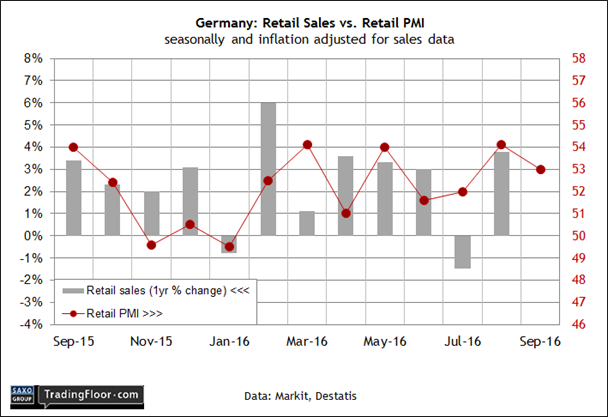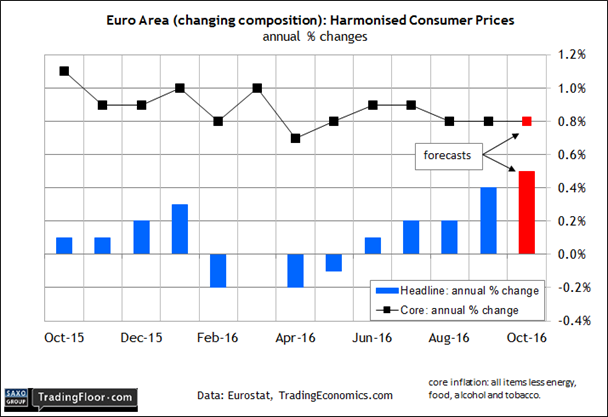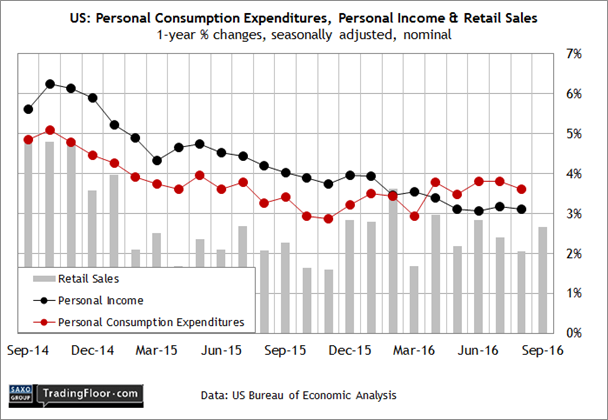- German retail spending report could show signs of firmer Eurozone growth
- The annual pace of Eurozone headline inflation to tick up to a two-year high
- Expect a rebound in US personal income and spending for September
German retail sales for the flash estimate of Eurozone consumer inflation in October are key releases for Monday. For the US, the personal income and spending report is the main event for today’s economic news.
Germany: Retail Sales (0700 GMT): Recent data suggests that Germany’s economy is on a modest rebound after wavering in the summer. In today’s report, the market will learn if the hard numbers on consumer spending support the argument that Europe’s economic engine is shifting into higher gear.
Survey data certainly looks encouraging. The preliminary PMI estimates for October point to a modestly firmer pace of growth.
“The German economy has entered the fast lane again at the start of the fourth quarter, with output growth accelerating from September’s recent low,” said the chief economist at IHS Markit last week.
The Germany PMI Composite Output Index jumped to a 55.1 reading for October, a three-month high that signals faster growth in the final quarter of 2016.
The upbeat news for Germany is a factor in the latest increase in Eurozone GDP estimates.
Now-casting.com’s latest projections for third quarter growth in the euro area ticked up to a quarterly rise of 0.47%, a respectable improvement over Q2’s 0.30% advance.
The outlook for Q4 GDP is even better at 0.66%, according to Friday’s updated estimates.
Today’s retail numbers for Germany in September offer another perspective for deciding what lies ahead.
Recent numbers point to moderate growth in spending. Retail sales increased 3.8% in August against the year-earlier level, and PMI data for the industry suggest that a healthy expansion will endure.
If spending remains firmly in the black in year-over-year terms in September, the outlook for Germany and Europe will remain upbeat.

Eurozone: Consumer Price Index (1000 GMT): Deflation risk appears to be fading as a clear and present danger for the Eurozone and today’s preliminary estimate for consumer prices in October looks set to seal the deal.
Some forecasts are looking for an uptick in the rate of increase in the headline consumer price index for October against the year-earlier level.
TradingEconomics.com, for example, is projecting a 0.5% increase in the annual pace. That’s still a low rate, but the forecast represents the strongest rise in over two years.
If accurate, the increase will offer more evidence for arguing that inflation's brief dip into negative terrain earlier this year was a temporary setback that's now fading.
Keep in mind that core inflation, which is considered a leading indicator for headline prices, has consistently been higher, running closer to 1.0% for much of 2016. The firmer trend implies that the general trend for prices has an upside bias in the near term.
Meantime, the European Central Bank remains committed to boosting pricing pressure. “Until inflation is at a sustainable path to the current target [of just below 2%], the current policy of accommodation will continue,” said Irish central bank chief Philip Lane, who’s also an ECB Governing Council member, on Friday.
The bond market’s on board with the notion that inflation is firming. The German government's 10-year bond yield has jumped lately, returning to a positive current yield after spending most of the summer in sub-zero territory.
The benchmark rate is now just under 0.17%, close to the highest level since May.
Short of a major downside surprise in today’s CPI release, it’s time to start considering the implications for a post-deflation climate in the Eurozone.

US: Personal Income and Spending (1230 GMT): Economic output increased 2.9% in the third quarter, beating expectations and posting the strongest rise in two years, according to Friday’s initial GDP estimate.
But the underlying mix that produced the gain looks a bit wobbly. Will today’s personal income and spending data for September renew the crowd’s faith in the US macro outlook?
The GDP update raised questions because it was powered by inventory accumulation and exports. Meanwhile, consumer spending slowed in Q3, although the 2.1% quarterly advance is still a respectable rate.
Note, however, that the cyclically sensitive durable goods slice of personal consumption expenditures continued to rise at a strong pace of just below 10% (seasonally adjusted annual rate) for the second quarter in a row.
Today’s September report on income and spending will offer a more granular look at how the consumer sector fared at Q3’s close.
Economists are looking for upbeat data. Econoday.com’s consensus forecast sees personal income strengthening to a 0.4% monthly advance in September against 0.2% previously while consumer spending is on track to jump 0.5% after no change in August.
The predictions will provide support for the year-on-year comparisons.
Indeed, the previously released data for retail sales in October revealed a modestly firmer year-over-year gain. That’s a sign for thinking that today’s report on consumer spending will also post an uptick in the annual trend.
“Bottom line, the US economic expansion remains resilient, yet unremarkable,” noted the senior economist at Wells Fargo Securities on Friday.

Disclosure: Originally published at Saxo Bank TradingFloor.com
